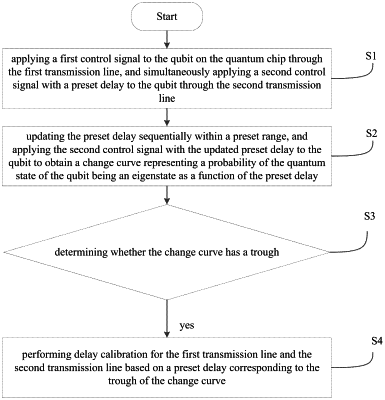| CPC H03K 5/01 (2013.01) [G06N 10/40 (2022.01); H03K 2005/00058 (2013.01)] | 20 Claims |

|
1. A calibration method for a delay of a quantum computer system, comprising a quantum chip and a first transmission line and a second transmission line connecting a qubit on the quantum chip, wherein the calibration method comprises:
applying a first control signal to the qubit on the quantum chip through the first transmission line, and simultaneously applying a second control signal with a preset delay to the qubit through the second transmission line; wherein the first control signal is to control a quantum state of the qubit to an eigenstate, the second control signal is to control a frequency of the qubit, and a change of the frequency of the qubit affects a probability of the quantum state being an eigenstate;
updating the preset delay sequentially within a preset range, and applying the second control signal with the updated preset delay to the qubit to obtain a change curve representing a probability of the quantum state of the qubit being an eigenstate as a function of the preset delay; wherein the preset range is set according to lengths of the first transmission line and the second transmission line;
determining whether the change curve has a trough; and if the change curve has a trough, performing delay calibration for the first transmission line and the second transmission line based on a preset delay corresponding to the trough of the change curve.
|